To read a scientific paper published by myself and Roger Dennis in the Chinese journal Acta Zoologica Sinica following a study by myself on shifting of habitats and adaptation of butterfy species in the vicinity of Binangonan, Rizal, Philippines in 2007, please click on the following link:
For something simpler, more suitable for the general viewer with some interest in butterflies, wildlife habitats, land use and conservation, read on.
We are forever reading of destruction of rain-forest habittas due to the ever-increasing demands of the expanding human population, and warnings of mass species extinctions - I am not pretending for one minute to deny the magnitude of that problem. Can we not, however, take a more optimistic view - many of the other living things with which we share the planet have amazing powers of resistance and adaptability and, provided that we are aware of them and, even if we do not specifically manage the environment for their needs, if we can at least be aware of them and not deliberately set out to destroy them or their habitats unnecessarily, they should be able to continue to coexist.
My list of butterfly species occurring in Metro Manila stands at 41; this may not seem many compared with a total of just over 900 for the whole of the Philippines; nevertheless it is a substantial number and more than would be found in an equivalent conurbation (e.g. "Greater Manchester") in the U.K. It should also be borne in mind that (a) the nationwide total of 900+includes many very localised species and species endemic to certain islands; (b) the extent of my coverage of the area in Manila is nowhere near as great as in Manchester, so it is likely that there are quite a few species which I have missed; (c) sometimes it is difficult to distinguish between a number of very similar species, so the Manila total may well be quite a bit higher. At Binangonan, a mere 33 kilometres (20 miles) to the east of the centre of Manila, my total of recorded species is 75.
LOCATION OF BINANGONAN
I wonder - assuming this website is read by anyone - whether it will be by readers in the Philippines, to whom the location of the sites mentioned will be familiar, or in the U.K., or in any other country - bearing in mind that the paper which I managed to get published on my 2007 study was in a CHINESE journal? For anyone who does not know, the following map shows the location of Binagonan: it is slightly to the east of the centre, on a pr0montory reaching southwards from the north side of the large lake named Laguna de Bay.

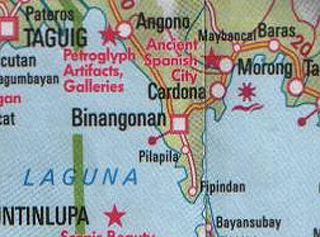
Here are some satellite pictures from "Google Earth" showing the study area, which was centred on Ynares, to the north-west of Binangonan town proper. The first (not very clear I am afraid) covers the whole area in which any butterflies were seen during the study period and ranges from just south of Angono in the north-west to the vicinity of the Carlos Hospital, Cardona. Note that there is a concentration of records along the road leading north-eastwards from the Manila-Binangonan coastal road; this road leads through the district of Pantok to the settlement of Ynares Village near the top of a south-facing hillside and then on to a quarry.
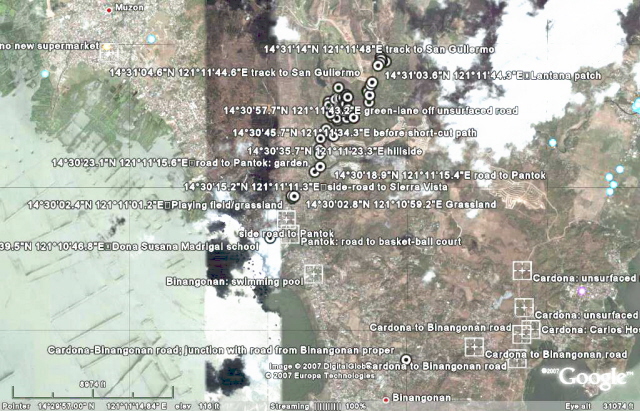
The second map shows in more detail the road through Pantok to Ynares, and the large settlements ("subdivisions") which have developed in recent years to the east of that road.
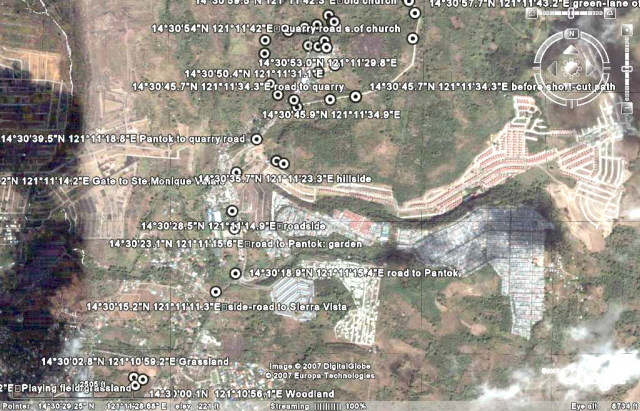
Next is a map showing the settlement of Ynares (the triangular area of builings just south of the centre of the map), and the road leading onwards to the quarry; after Ynares, the road is unurfaced (or at any rate was in 2007) and shows up lighter in the satellite view in consequence.
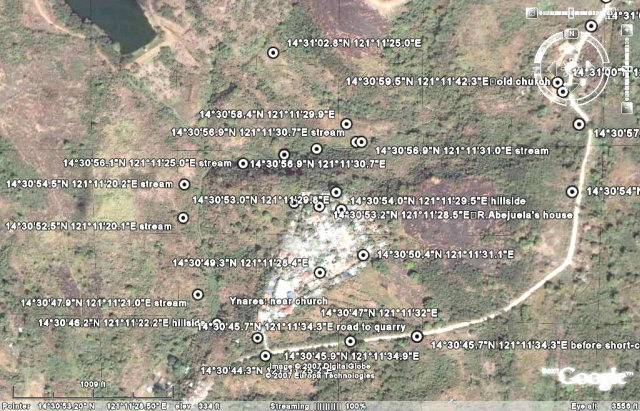
Next is the road leading on northwards to the quarry - the buildings just north of the last marked location on the map are the limit of public access and the quarry itself is the pale brown expanse to the north of this point. The light green area in the centre of the map is an elite golf course; to the west of that is visible a reservoir constucted by damming a stream.
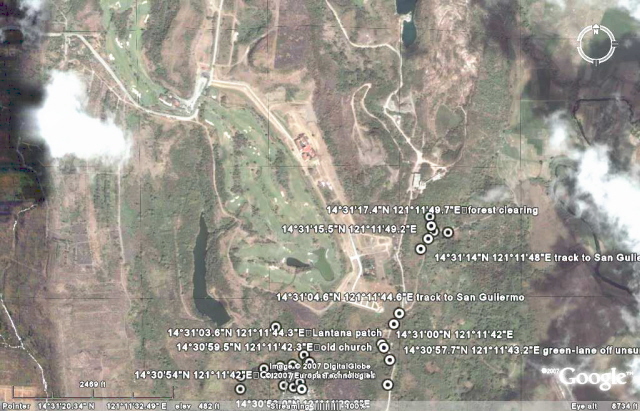
The final satellite map is a closer view of Ynares village itself. The house at which I was based during the study is at the north-west; the village slopes quite steeply downwards from north to south, and to the west the ground slopes steeply down to a stream (visible on the map as a green thread running north to south) and then up again the other side of the stream. The land to the east of the village is flatter and more under cultivation.
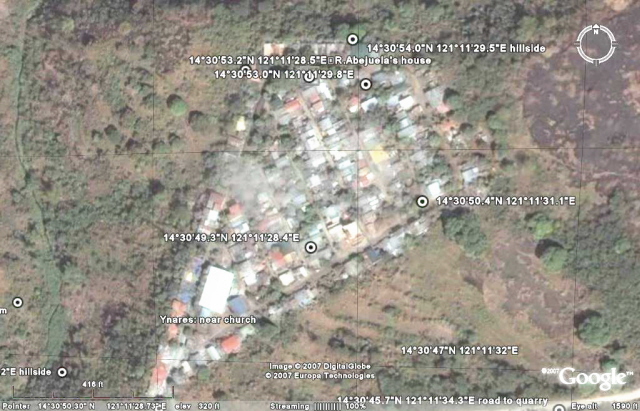
I first knew this locality in 1998, when many of the plots in Ynares had not yet been built over - even though a sign on the gate states that it was founded in 1984. Quarry Road, up from Pantok, was still unsurfaced. During 2000 to 2002 when I lived in the Philippines at Indang, Cavite, I made quite regular visits to Binangonan; by then most of the plots had been built over, and the road had been surfaced up to the Ynares gate. The houses in Ynares were mostly small, not to any standard design, and although the village was quite densely populated within its compact area, some greenery was able to coexist and the feeling of openness remained. The first photograph below illustrates a typical street scene in the village in early 2001 (the baby girl in the tricycle is my daughter Lirio, then aged 1). The second picture shows the exterior of my father-in-law, Rafael Abejuela's, house, at the extreme north-west of the village, in 2007; the trees in the small garden in front of the house and just across the street leading eastwards formed an "edge effect" and even though they faced westwards were very well favoured by Hesperiids warming-up in the early morning.
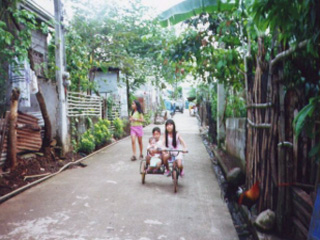
To the west of this house, behind the houses on the opposite side of the street, the terrain sloped steeply downwards to the stream; the next picture is taken from the other side of the valley looking up at the slope; the row of houses including R. Abejuela's is just visible at the base of the intermittent line of semi-mature trees towards the top of the photograph. The following view is taken from just behind the houses, looking across the valley in the other direction, towards the west side. These photographs were taken in August 2007.
In 2000/1 when I first discovered the access to this valley, both sides were largely covered in a very fair approximation of secondary forest and, apart from the aeroplanes forever passing overhead - Binanogonan is under one of the flight-paths to Manila airport - could feel like somewhere really out in the wilds. During 2001 and 2002, however, the slopes became more and more cultivated - cassava, sweet-potatoes, yams and the like - and during the dry season of 2002 the eastern slope was very desiccated and much of it was almost bare of vegetation. After a lapse of 3.1/4 years, I returned briefly to Binangonan in December 2005/January 2006; there did not appear to be any longer any access to the slopes above the stream, though the walk towards the quarry was still possible. On that occasion, for the second time I had a look at the "subdivison" named "Ste. Monique Valais": see the second of the satellite maps above; it is the the long, initially narrow but broadening out considerably towards the east strip of urbanisation which dominates the centre and east side of the map; note how it was at the time of the satellite picture being considerably enlarged at the south-eastern end. On my first visit to the "subdivision", I had asked what the previous land use had been prior to its construction, and was not exactly overjoyed when advised that it had been "forest" - i.e. the building of the "subdivision" had destoyed an area of forest. On the second visit, I was even more disturbed to note that another hill, visible in the mid-distance, had been carved all around with what was intended to be roads to facilitate even more "subdivision" construction. It did not look good.
A year and a half later, however, when I managed what I now fear will have been my last ever visit to Binangonan or to the Philippines at all - for a month in August 2007 - I found that it was not quite as bad as I had feared. It WAS still possible to gain access to the stream and the sloping valley sides - and further that there was not as much cultivation, and that some good rains had brought about quite a bit of fighting-back by Nature so that the valley sides were again green - see the two pictures above.
Below is a view of the stream itself (with nephew Luis, appropriately in green as a true forest child); along the sides of the stream quite a few trees remained and it formed a strip of secondary forest. Less innocent however is the next picture: the wiew is just to the north of the right-hand photograph of the pair above, and shows horrendous disturbance of the hillside - trees dying, a vast pile of bare soil realigned over and down the hillside with no apparent regard to what was below, preparatory to constructing yet another housing "subdivision" at the edge of the golf course. Run-off was pouring into the stream every time it rained, silting it up and affecting the hydrology and clearly having an effect on the streamside vegetation.
Beyond the entrance to Ynares, in 2007 Quarry Road was still an unsurfaced track, with good roadside butterfly habitat, as seen in the following view (with nephew Clarke). Approaching the quarry, a grassy track led off to the right, eastwards, towards the small settlement of San Guliermo; this track and its egdes formed splendid habitat for grassland species, and to the left the steep hillside below the quarry still retained some forest cover. The flat plain beyond, visible in the distance in the second picture below, was mainly agricultural, but not (yet) very much built over. Nephew Daniel, in the foreground, feeling the heat, was out for a walk with some other boys, including Luis, being shown some of the beauties of Nature, especially the butterflies.
LARVAL HOSTPLANTS
As regards the usage of hostplants in Binangonan, the little information I have is from Daniel, who used to be very good at finding caterpillars. In 2001 (then aged 6) he found the rather splendid Skipper Bibasis gomata, commonly known as the "Pale Awl" or "Pale Green Awlet", breeding on a Scheffleria bush in his great-uncle's garden



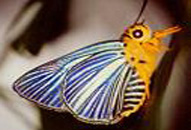
and in 2002, not long before I left the Philippines to return to the U.K., he found two Papilionid caterpillars on an "Indian Tree" Polyalthia longifolia, one of which, when bred out, was Graphium agamemnon, the "Tailed Jay", and the other was G. doson, the "Common Jay" (though I have not found it to be particularly "common" in the Philippines):



Larvae of Papilio demoleus, the "Lime", were regularly found on Citrus plants; and once the spectacular P. rumanzovia, the "Red Mormon" was observed egg-laying on a Citrus in R. Abeuela's garden:
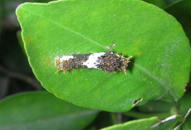
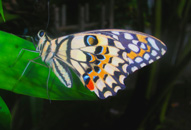
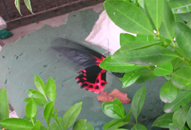
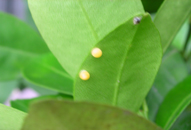
ADULT NUTRITION
The paper published in the Chinese journal is mainly about nectar sources. Here are some of the plants used: first, in front of R. Abejuela's house, Pseuderanthemum reticulatum ("False Eranthemum"), a shrub introduced from Melanesia, was extremely polular with the small Hesperiids ("Skippers"), throughout the day but especially early in the morning; shown here are in the first picture Borbo cinnara and Pelopidas mathias; in the second Pelopidas mathias and Telicota augias; these plants also attracted larger butterflies including the magnificent Doleschallia bisaltide (the "Autumn Leaf") and Hypolimnas bolina (the "Great Eggfly");
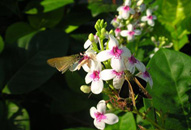
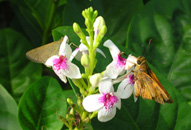
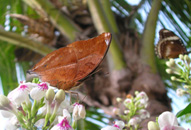
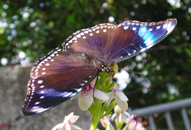
Pareronia boebera (the "Wanderer"), and, once, a "Lacewing", Cethosia biblis (upperside and underside shown). Another good nectar source in some gardens in the village was Turnera ulmifolia, known as "Yellow Alder", intoroduced from the West Indies/tropical America; this plant was only usable in the morning as its flowers always closed up in the afternoon.
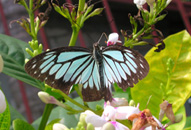

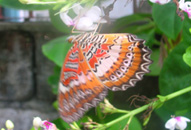
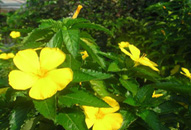
Below are Prusiana prusias taking nectar on this plant and Parnara kawazoei resting after having done so. Another garden plant sometimes used was the native Ixora coccinea ("Santan"/"Jungle Geranium"); a "Great Orange-Tip" Hebomoia glaucippe is shown below using it, and a "Lime", Papilio demoleus.
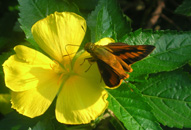
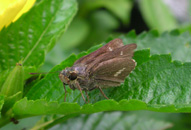
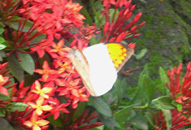
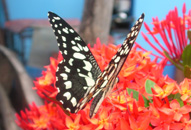
What nectar plants did the butterflies use away from gardens? Beside the stream, the native "Mali-mali" tree Leea philippinensis was very favoured; there were several of these trees and always numbers of white Pierids around them, high up and out of photographic reach (though a single Appias lyncida is just visible in the picture). In several places, especially along a short track off Quarry Road, another native shrub Deeringia polysperma ("Bayambang") was very attractive, especially to the large Nymphalids (here a large unidentified Noctuid moth is seen using it). Another native tree used for nectar, especially by Taractrocera luzonensis - see the third photograph in the line below - was the "Noni" Morinda citrifolia: there was a single large tree by the side of Quarry Road at the start of the unsurfaced section,beside where Clarke is standing in the picture seven rows above. The other picture is one taken from another source, showing the "Noni" tree's fruit.
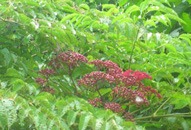
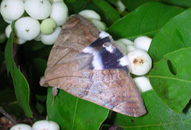
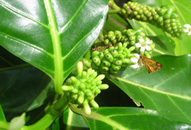
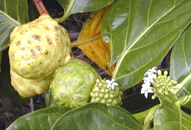
Along the sides of Quarry Road, and in scraps of waste ground, and also in a little glade in the bit of forest on the sloping hillside along the track from near the end of Quarry Road towards San Guliermo, were frequent Lantana bushes Lantana camara. This plant is from tropical America; in many parts of the Philippines it has become invasive; some strains however are planted in parks and gardens. It is a very popular nectar source, and here are some of the butterflies using it around Binangonan: Graphium euphrates, Appias lyncida, Spindasis syama and a female Pareronia boebera.


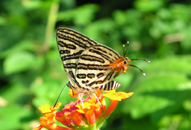
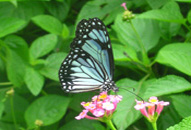
Also captured above Quarry Road, near an old church, was this "Green Dragontail" Lamproptera meges on Tridax procumbens ("Tridax daisy" or "Coatbuttons"), another tropical American plant which has become widespread and sometimes regarded as invasive but which is an extremely welcome source of nectar on waste ground, road edges and the like. It was popular with the "Pansies", and here a "Lemon Pansy" Junonia lemonias and a "Peacock Pansy" J. almana are jostling for position on a flower, on the west-facing slope just west of the village, below the houses and above the stream. The small size of the "Tiny Grass Blue" Zizula hylax is emphasised by this close-up of one on a Tridax flower head. The photograph of a Taractrocera luzonensis using Muntingia calabura ("Datiles"/"Jamaican Cherry"), a fruiting tree native to tropical America, was taken at a point further south, beside the surfaced part of Quarry Road, at a small bridge over the stream.
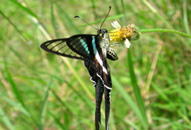
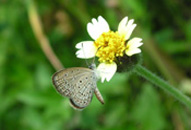
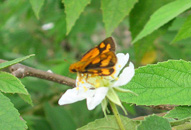
Other roadside flowers of non-native origin, used as nectar sources along the verges of the unsurfaced road included Ipomoea triloba ("Kamo-kamotehan", "Littlebell", "Morning-glory") and Ruellia tuberosa ("Meadow weed"), again both from central America/the West Indies. Also popular (though not very exciting-looking!) was Euphorbia heterophylla (Kanaka), yet again from Central America: the third picture below shows the flowers in close-up and the fourth shows Cepora aspasia using them.
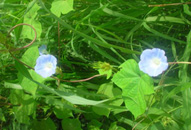
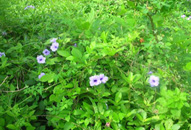
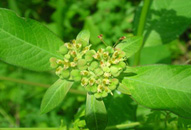
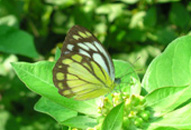
As regards nutrition from other sources, I occasionally observed "mud-puddling" by the stream, as in the case of the "Cruiser" Vindula dejone, and on the surfaces of the the rough roads, as with this Graphium sarpedon and G. euphrates; but the Papilio demoleus seems more interested in the dried vegetation than the ground itself?
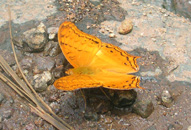
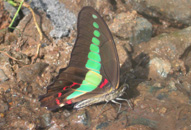
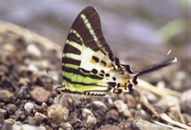
This "Peacock Pansy" Junonia almana seems just to be basking on the stones of Quarry Road (though I have seen J. almana taking nutrition from the road); the "Blue Pansy" J. orithya is just resting on a grass stem.
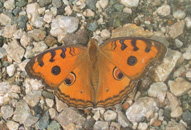
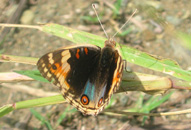
click here to view the full list of my butterfly observations during the study, showing the dates, exact locations, and nectar plants when used
click here for a full list of all identified nectar plants
WHAT POINT WAS I TRYING TO MAKE FROM THIS STUDY?
What would the world be, once bereft
Of wet and of wildness? Let them be left,
O let them be left, wildness and wet;
Long live the weeds and the wilderness yet.
-- Gerard Manley Hopkins
The scientific paper published in the Chinese journal largely shows the adaptability of certain butterfly species so that they can continue to thrive inhabitats severely and increasingly modified by man. Just how far however are they capable of doing so?
The settlements around Pantok, including Ynares, certainly do not represent a self-sufficient rural community. They are largely "overspill" from Manila. Although the inhabitants and their accommodation take up vastly less space than would an equivalent number of human beings in a country such as Britain, still their ever-increasing demand for housing, food and the other necessities and comforts of life has a very big impact on the environment and the signs are very much that it is going to carry on increasing. If new "subdivisions" develop further along Quarry Road, the present unsurfaced portion is likely to be turned into a metalled road and the verges and hedgerows will disappear. The stream risks pollution from waste as well as run-off from the damage on the hillside.
In a natural state, the whole area should look like the picture below.
D.H. Lawrence in St. Mawr refers to "these awful, house-bred, house-inbred human beings".
It would of course be totally unrealistic to suggest that the environment around Binangonan could ever revert wholly to its natural state of rain-forest cover. - nevertheless it has a vast amount of resilience. I left Binangonan in 2002 on a note of pessimism; the buildings and the cultivation seemed to be rapidly taking over, the (semi-)natural vegetation had largely gone from the slopes above the stream; the stream indeed was dry most of the time. My short visit in 2005 did little to assuage my fears. In 2007 however I felt there was still a chance - perhaps it was the result of a good rainy season, but much vegetation had returned to the slopes, the sites were in fact still accessible, and the butterflies were still present and in very good numbers - indeed I recorded several species which I had not previously seen there.
Are the present, and future, inhabitants of Ynares and neighbourhood going to appreciate the natural world around them - the butterflies, the trees, the whole dynamic ecosystem - indeed, is it going to remain in recognisable form and are they going to be able to go out into it and learn to be a part of it - walk in it, the younger generation play in it, WITHOUT damaging it? - or are they just going to become "house-bred, house-inbred" with no thought for the wonders outdoors?
My thoughts varied between joy that so much in the way of butterflies and usable resources had after all managed to survive and consciousnesss that this was not because of any understanding or assistance on the part of the human beings, be they property-developers, farmers, workers from Manila or whatever.
POSTSCRIPT 2011
Although I had not expected to visit the Philippines again after 2007, owing to an unexpected turn of events I did find myself there for a short while in August 2011 and this included a very brief visit to Ynares. I did not have an opportunity to revist any of the sites from my previous visits, but I did notice that Quarry Road had NOT been surfaced beyond the entrance to Ynares, and most of the little I saw did not look significantly different from four years previously. There is hope.
FURTHER NOTE - 2017
Six years have passed sine the last entry. I visited Binangonan again in August 2017. Alas, Quarry Road was in the process of being "upgraded" - see these photographs:
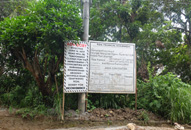

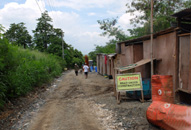
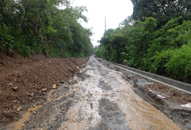
The notice in the first picture reads: "Effective June 16, 2017 road will be temporarily closed for the improvement/concreting of Darangan, Binangonan - Angono - Antipolo road (Eastridge), Rizal. Sorry for inconvenience". The wet-looking man in the second picture is my brother-in-law Emmanuel Abejuela ("Intoy"), who accompanied me on all these walks. The third shows the workmen's huts; the fourth is taken from the same point as the photograph taken with Clarke ten years previously (see above). There were no longer very many butterflies along this stretch of the road.
Further along, it appeared that yet another "developer" had started building a "subdivsion" to the left of the road, but the project had apparently stopped after only a few houses were built; some were inhabited but most seemed to have been abandoned:
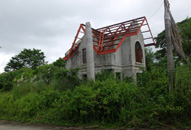

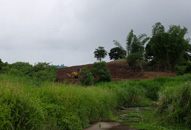
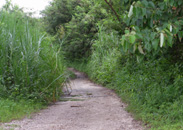
There were signs of further earth-moving behind the subdivision towards the golf course (third picture in above row); however, in much of the site the regenerating vegetation did provide habitat for some grassland butterfly species, there were quite a few Lantana bushes which provided nectar sources, and a few surviving scraps of semi-natural vegetation, as in the fourth picture on the above row, showing the far end of Quarry Road.
It was no longer possible to get down to the stream below Ynares village. The former (unofficial) path had been completely overgrown.
There are however still quite a number of butterflies to be seen in this vicinity; during seven days of observation I recorded 42 species: Chilasa clytia, Papilio demoleus, Papilio alphenor, Graphium sarpedon, Graphium agamemnon, Graphium euphrates, Lamproptera meges, Catopsilia pyranthe, Catopsilia pomona, Eurema hecabe, Cepora aspasia, Pareronia boebera, Hebomoia glaucippe, Phalanta phalantha, Junonia hedonia, Junonia almana, Junonia lemonias, Hypolimnas bolina, Cyrestis maenalis, Neptis mindorana, Pantoporia dama, Phaedyma columela, Melanitis leda, Mycalesis mineus, Mycalesis igoleta, Ypthima stellera, Ideopsis juventa, Tirumala limniace, Caleta roxus, Prosotas dubiosa, Zizina otis, Zizula hylax, Euchrysops cnejus, Spindasis syama, Tagiades japetus, Suastus migreus, Taractrocera luzonensis, Potanthus pava, Telicota ancilla, Borbo cinnara, Parnara kawazoei, Pelopidas mathias.